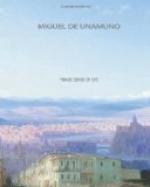The poem, despite its length, easily maintains this lofty level throughout, and if he had written nothing else Unamuno would still remain as having given to Spanish letters the noblest and most sustained lyrical flight in the language. It abounds in passages of ample beauty and often strikes a note of primitive strength in the true Old Testament style. It is most distinctively a poem in a major key, in a group with Paradise Lost and The Excursion, but in a tone halfway between the two; and, as coming from the most Northern-minded and substantial poet that Spain ever had, wholly free from that tendency towards grandiloquence and Ciceronian drapery which blighted previous similar efforts in Spain. Its weakness lies in a certain monotony due to the interplay of Unamuno’s two main limitations as an artist: the absolute surrender to one dominant thought and a certain deficiency of form bordering here on contempt. The plan is but a loose sequence of meditations on successive aspects of Christ as suggested by images or advocations of His divine person, or even of parts of His human body: Lion, Bull, Lily, Sword, Crown, Head, Knees. Each meditation is treated in a period of blank verse, usually of a beautiful texture, the splendour of which is due less to actual images than to the inner vigour of ideas and the eagerness with which even the simplest facts are interpreted into significant symbols. Yet, sometimes, this blank verse becomes hard and stony under the stubborn hammering of a too insistent mind, and the device of ending each meditation with a line accented on its last syllable tends but to increase the monotony of the whole.
Blank verse is never the best medium for poets of a strong masculine inspiration, for it does not sufficiently correct their usual deficiency in form. Such poets are usually at their best when they bind themselves to the discipline of existing forms and particularly when they limit the movements of their muse to the “sonnet’s scanty plot of ground.” Unamuno’s best poetry, as Wordsworth’s, is in his sonnets. His Rosario de Sonetos Liricos, published in 1911, contains some of the finest sonnets in the Spanish language. There is variety in this volume—more at least than is usual in Unamuno: from comments on events of local politics (sonnet lii.) which savour of the more prosaic side of Wordsworth, to meditations on space and time such as that sonnet xxxvii., so reminiscent of Shelley’s Ozymandias of Egypt; from a suggestive homily to a “Don Juan of Ideas” whose thirst for knowledge is “not love of truth, but intellectual lust,” and whose “thought is therefore sterile” (sonnet cvii.), to an exquisitely rendered moonlight love scene (sonnet civ.). The author’s main theme itself, which of course occupies a prominent part in the series, appears treated under many different lights and in genuinely poetical moods which truly do justice to the inherent wealth of poetical inspiration which it contains. Many a sonnet might be quoted here, and in particular that sombre and fateful poem Nihil Novum sub Sole (cxxiii.), which defeats its own theme by the striking originality of its inspiration.




